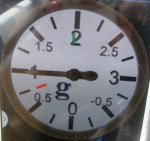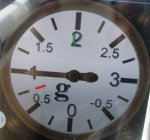- Joined
- Oct 30, 2003
- Messages
- 18,374
- Location
- Santa Maria, California
- Aircraft
- Givens Predator
- Total Flight Time
- 2600+ in rotorcraft
Based on a post by Paul Plack I checked Ed’s phone and it had a free G meter.
I borrowed Ed’s phone today and did some maneuvering.
I don’t know how accurate the accelerometer on her phone is although it agrees roughly with the aviation accelerometer I borrowed from John Ready.
It certainly was consistent.
The first picture is steep turns and the maximum was just under two Gs.
The second picture after a reset was a pull up from a dive and again it was just under two Gs.
The third picture was all kinds of maneuvering in the pattern and two landings and again it was just under two Gs.
Before someone asks; yes I did reset the min and max before each flight in the run-up area.
I didn’t know it was that consistent till I looked at the pictures when I got home.
More interesting to me was that I was not able to get below .75Gs even with the 12kt gust spread and leveling off from a zoom climb.
The highest rotor rpm I saw was a little over 430 and the lowest was just under 270 rotor rpm.
I will try again when it is less windy, I am more comfortable maneuvering and cloud conditions are better.
I used Velcro to mount the phone at the front of my little glove box thing and I could watch it while maneuvering.
Thank you, Vance
I borrowed Ed’s phone today and did some maneuvering.
I don’t know how accurate the accelerometer on her phone is although it agrees roughly with the aviation accelerometer I borrowed from John Ready.
It certainly was consistent.
The first picture is steep turns and the maximum was just under two Gs.
The second picture after a reset was a pull up from a dive and again it was just under two Gs.
The third picture was all kinds of maneuvering in the pattern and two landings and again it was just under two Gs.
Before someone asks; yes I did reset the min and max before each flight in the run-up area.
I didn’t know it was that consistent till I looked at the pictures when I got home.
More interesting to me was that I was not able to get below .75Gs even with the 12kt gust spread and leveling off from a zoom climb.
The highest rotor rpm I saw was a little over 430 and the lowest was just under 270 rotor rpm.
I will try again when it is less windy, I am more comfortable maneuvering and cloud conditions are better.
I used Velcro to mount the phone at the front of my little glove box thing and I could watch it while maneuvering.
Thank you, Vance



